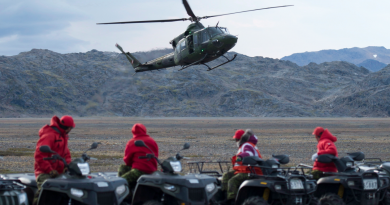White House releases U.S. Arctic strategy implementation plan

Partnership with Canada on North American Aerospace Defense Command (NORAD) modernization are amongst the top security priorities outlined in the new U.S. Arctic strategy implementation plan released on Monday.
“We will invest in modernized domain awareness to detect and track potential airborne and maritime threats and improve sensing and observational capabilities, including for sea ice, ship traffic, and weather,” the document said.
“For example, we will collaborate with Canada on North American Aerospace Defense Command (NORAD) modernization.”
The NORAD priority was first established in the U.S. National Strategy for the Arctic in October 2022, a plan that emphasized the need for a more proactive stance on climate change and the importance of enhancing Washington’s ability to “compete and manage” tensions in the region in the wake of Russia’s invasion of Ukraine.
The 2022-2023 plan stressed four pillars: security; climate change and environmental protection; sustainable economic development; and international cooperation and governance.
Better understanding of how to operate in the North was among the strategic objectives outlined, including through collaborating with Canada on NORAD
Modernizing continental defense
The implementation plan released this week lays out how the 10-year strategy will be carried out, which government departments will be responsible for what and how the plan will work together with other levels of government, the business sector and international partners.
- Partner with Canada as it invests $4.9 billion (Canadian Dollars) over the next six years to modernize its continental defense and coordinate closely with Canada, consistent with
the Joint Statement on NORAD Modernization, on investments to modernize, improve, and better integrate NORAD capabilities.
NORAD has provided continental defence of North America for over sixty years, but urgently requires modernization.
Set up in 1958 during the Cold War, NORAD’s mandate was to provide aerospace warning and control against Soviet aerial threats to North America. Maritime warning was added to its mandate in 2006.

Currently, a chain of unmanned long and short-range radar station sites built between 1986 and 1992 stretches across the Arctic, but they are not able to keep up with with evolving weapons technologies used in Russia and China like long-range cruise missiles and hypersonic weapons.
In the wake of Russia’s invasion of Ukraine, the Canadian government finally announced in 2022 it would spend $4.9 billion over the six years to modernize continental defence.
Write to Eilís Quinn at eilis.quinn(at)cbc.ca
Related stories from around the North:
Canada: CSIS warning Inuit leaders about covert foreign investment in Arctic, documents show, CBC News
China: Satellite imagery reveals construction progress on new Chinese Antarctic base, Eye on the Arctic
Denmark: Danish policy prioritizes low-conflict Arctic amidst Russian tensions, Eye on the Arctic
Finland: China ship is focus of pipeline damage probe, Finland says, Reuters
Iceland: Nordics should aim for common approach to China’s Arctic involvement says report, Eye on the Arctic
Norway: Svalbard’s travails in a changing Arctic, Blog by Marc Lanteigne
Russia: Putin tells Xi: We will connect Kola Bay with Persian Gulf, The Independent Barents Observer
United Kingdom: Russia’s growing dependence on China altering dynamics in Arctic, UK committee hears, Eye on the Arctic
United States: Russian, Chinese vessels near Alaska reminder of ‘new era of aggression’: Senators, Eye on the Arctic



